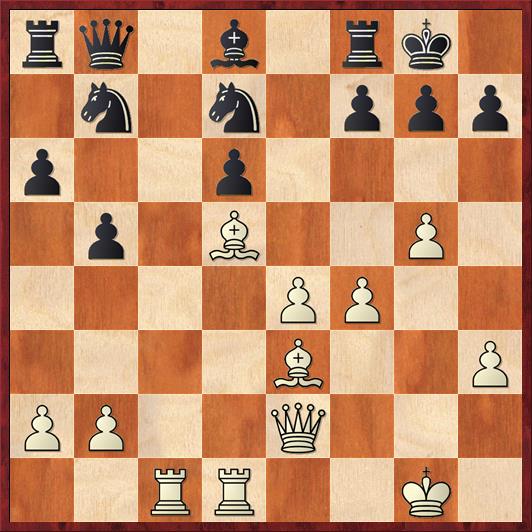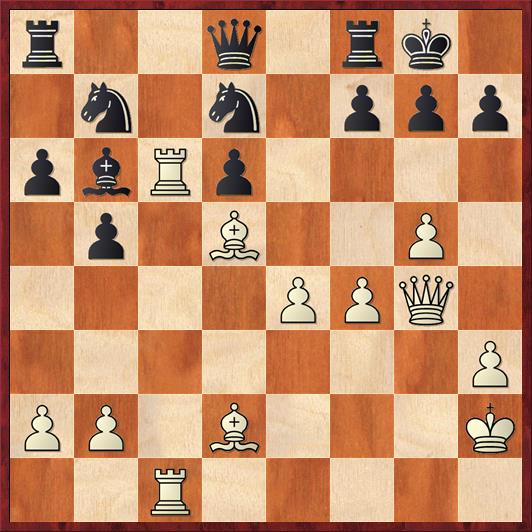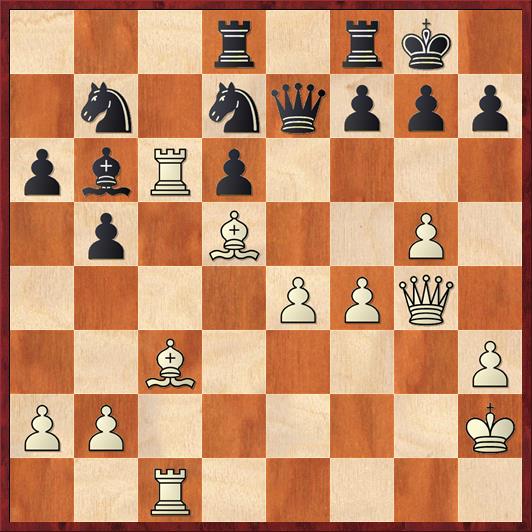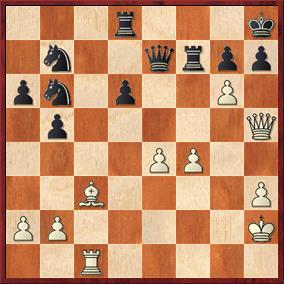At Mike Splane’s chess party last weekend, Gary Kelly showed an exceptionally interesting game that he played, I believe, last week at the Kolty Chess Club. We started in the following position:
Position after 0. … Bd8. White to move.
FEN: rq1b1rk1/1n1n1ppp/p2p4/1p1B2P1/4PP2/4B2P/PP2Q3/2RR2K1 w – – 0 1
Because Gary didn’t show us the previous moves, I can’t tell you exactly how we got here, but the most important thing we can see is that Gary (who is White) has sacrificed a full piece to obtain a position with tremendous attacking potential. White dominates on the kingside, the center, and the queenside. Black’s pieces are incredibly tied up, several of them (e.g., the queen) having no reasonable moves. But a piece is a lot of material, and White does not have any direct, immediate threats. What should he do?
There are lots of things to consider: Qg4, Qg2, e5, h4, etc. But it is really too soon for very committing action on the kingside, because White’s pieces are not really pointing that direction (except for the bishop on d5 and the queen). I think that Gary found exactly the best solution, although it took a while for the rest of us at the chess party to fully appreciate it.
The key question to ask yourself in this position is, “What does my opponent want to do?” Black has two main defensive ideas, and White has one move that squelches both of them. What is it?
(Space inserted if you want to think about it.)
1. Rc6! …
An outstanding move that combines strategy and tactics. It uses tactics in the service of strategy, which is the sign of a truly strong player.
Here is White’s thinking: “Black has two moves he would like to play to get out of his bind: 1. … Bb6 to trade off the dark-squared bishops, or 1. … Nbc5 to activate his worst piece and transfer it over to e6, where it can help defend the kingside. He would be absolutely delighted to trade his do-nothing rook on a8 for my best pieces, the bishop on d5.”
“1. Rc6! prevents both of these moves. Of course 1. … Bb6 now loses a piece. More subtly, 1. … Nbc6 runs into 2. Rxd6! Qxd6 3. Bxf7+! winning Black’s queen. Although material ends up more or less equal in that line, it is an ideal position for White’s queen, and the rampaging e- and f-pawns will surely sweep away Black’s disorganized army. White is simply winning. Not only that, 1. … Ndc5 is also not very good because of 2. b4 Ne6 3. f5. The point is that, of the two knights, it’s really the b7 knight that Black wants to go to c5 with. He wants to keep the other knight at d7 so that he can meet f5 with … Ne5.”
Here is how Craig Mar (2400 player, former top-100 player in the U.S.) sums it up: “One piece (the rook at c6) ties up five Black pieces (the rook at a8, queen at b8, bishop at d8, and the two knights. What an incredible bargain!”
This is why 1. Rc6 is so much better than the other moves. Even though it appears that White is blocking the d5-a8 diagonal, White doesn’t care about that because he has no intention of taking the a8 rook, except possibly as the cherry at the end of a combination. Even though it appears that White is playing on the wrong side of the board, he is optimizing the value of his pieces and, by tying up so many of Black’s pieces on the queenside, he is preparing the way for a successful kingside attack. A very deep and instructive move.
1. … Bc7?
Although it superficially makes sense because it defends the d-pawn, Black’s move fails to ask, “What does my opponent want to do?” White really wants to play 2. b4!, which would complete the bind and literally paralyze every one of Black’s pieces.
Therefore, Black must either stop 2. b4 or play the move that 2. b4 is intended to prevent. So there are only two moves for Black worth considering. One is 1. … Ba5 (preventing 2. b4). The other is 1. … Nbc5!
“Wait a minute!” I hear you saying. “Didn’t you just say that 1. … Nbc5 is bad? Wasn’t that the move that 1. Rc6 was intended to prevent?”
Well, here’s another hugely important principle in chess: If you can find a way to play the move that your opponent tried to stop, then do it. I will now give this principle a name: the “Do It Anyway” Principle. First, if nothing else, it affects your opponent psychologically. It can be downright discouraging when you try to stop your opponent from doing something and he does it anyway. But second, the “Do It Anyway” move is often the best move. If a move is strategically right, often it remains strategically right even if it costs some material.
And so it is in this case. After 1. … Nbc5! 2. Rxd6! Bc7! White can win back all of his material with 3. Rxd7 Nxd7 4. Bxa8 Bxf4 5. Rxd7 Bxe3+ 6. Qxe3 Qxa8, but the position that results is one where White is laboring a little. Although White’s pieces are more actively posted, he has huge pawn weaknesses that will be easy targets in a heavy-piece endgame, and Black has no weaknesses at all. Rybka evaluates the position at +0.15 for Black, and I agree. The tactical flurry has allowed Black to resolve all of his problems.
Now Gary, in turn, misses his opportunity.
2. Rdc1? …
How could this be wrong? Don’t you always want to double your rooks on the open file?
There is no “always” in chess. Every position has to be approached concretely. Here White should complete the plan initiated by his previous move: 2. b4! permanently prevents Black’s … Nbc5 idea, and White should thankfully take advantage of the fact that Black didn’t stop it on his last move. Also, as we saw in some of the lines above, White’s rook on d1 was actually well posted. It probably is not better posted on c1, and by playing this move we actually force Black into doing what he should have done before.
2. … Ba5! 3. Qg4 Qd8
This is not bad, but 3. … Nbc5 should also come under strong consideration, as the response 4. Rxd6 is no longer possible (because White moved his rook away from the d-file).
4. Kh2 Bb6 5. Bd2 …
It definitely feels as if White is losing the thread with moves like Kh2 and Bd2 — that’s not how you want to play an attack.
Now we have an interesting position where I strongly disagree with the computer’s recommendation.
Position after 5. Bd2. Black to move.
FEN: r2q1rk1/1n1n1ppp/pbRp4/1p1B2P1/4PPQ1/7P/PP1B3K/2R5 b – – 0 5
5. … Qe7?!
According to Rybka, this is Black’s best move. But I consider it a blunder for a human player! The reason is, again, that Black should be asking, “What does my opponent want to do?” The answer sticks out like a sore thumb. White wants to play Bc3. That is the whole point of his last move. With the bishop on c3, White has serious mating threats: g6, gh+ or gf+, and Qg7 mate. Without control over the a1-h8 diagonal, White’s attack is more bark than bite. There just aren’t any mating threats.
Therefore, with almost no thought required, Black’s best move has to be 5. … Bd4. There is no easy way for White to evict this bishop, and it helps Black hugely to have another piece available to defend the kingside.
Another version of “What does my opponent want to do?” is “How will my opponent win this game?” This is the flip side of the Mike Splane question, which I have written about so many times: “How will I win this game?” After Bc3 it’s really clear how White could win the game. After … Bd4 it is not clear at all.
6. Bc3! …
Whew! Now we’re back in business.
6. … Rad8?
Black continues to fiddle while Rome burns. For what it’s worth, here is what the computer saw: 6. … Be3! 7. Re1 b4!! 8. Bxb4 Nb6. Miraculously, Black activates his pieces; the bishop on e3 is taboo because of 9. Rxe3? Nxd5! This is computer chess, not human chess. So yes, for a computer, 5. … Qe7! was the right move because it saw all of this. For a human, 5. … Qe7? was the wrong move.
Actually I don’t want to criticize Black too much because he is slowly, methodically trying to untangle his pieces. But the trouble is that it’s too slow.
Position after 6. … Rad8. White to move.
FEN: 3r1rk1/1n1nqppp/pbRp4/1p1B2P1/4PPQ1/2B4P/PP5K/2R5 w – – 0 7
Okay, here’s a hint: White to play and win.
7. g6? …
Right idea, wrong move order. There is a beautiful forcing line, for which Austen Green should get the most credit because he found the key move to resuscitate what seemed to be a failing attack.
White should play 7. Rxb6!!, with the idea of deflecting Black’s knight away from the kingside. Of course, if Black doesn’t take the rook, then White wins a piece for free, and has full material equality and still a very strong attack. So 7. … Nxb6 is forced. Then White plays 8. g6! As in the game, the threat is to take either h7 or f7 with checkmate on g7 next move. Black has only one defense, but it turns out to be unexpectedly strong: 8. … Kh8! Now after 9. gf? Rxf7! 10. Bxf7 Qxf7 White’s attack comes up short. He’s sacrificed too much for too few threats.
This is when Austen spoke up with his bright idea: 9. Bxf7! At first it seems like just the same thing: 9. … Rxf7 (forced) 10. gf Qxf7 etc. But Austen said, “No! No! After 9. … Rxf7! we play 10. Qh5!!”
This position deserves a diagram.
Position after 10. Qh5 (analysis). Black to move.
FEN: 3r3k/1n2qrpp/pn1p2P1/1p5Q/4PP2/2B4P/PP5K/2R5 b – – 0 10
We just all sat there agog at Austen’s move. White is down a rook and a piece, with a couple more pawns hanging, but Black has no way out of the mating net. The sacrifice with 9. Bxf7 and 10. Qh5 is that rarest of creatures on the chessboard: an idea I don’t think I’ve seen before. With most tactical combinations, you can say, “Oh, that’s a discovered attack,” or “Oh, that’s a removal of the guard.” But what do you call this?
Well, I guess that in keeping with the theme of this post, it is the ultimate example of asking yourself, “What does my opponent want to do?” White sees that the move 9. Qh5 would be utterly crushing except that Black has one defense: 9. … fg. (That’s why Black moved his king to h8 in the first place.) So if we just remove the f-pawn, there’s no defense! It’s as simple as that. Perhaps you could call it a removal of the guard, except that the f-pawn wasn’t guarding anything in the usual sense of the word.
Anyway, Gary didn’t see this over the board. (Duh. I don’t think I would have, either.) His move, 7. g6, is not actually bad but it’s not as precise, because it allows Black another defensive idea.
7. … Nf6!? 8. gh+ Kh8
White’s pawn at h7 is now a “traitor pawn,” a favorite concept of Mike Splane. It is a better defender of Black’s kingside than a black pawn at h7 would be.
9. Bxf6 Qxf6
How inconvenient: Black would now answer 10. Rxb6 with 10. … Qxb2+, picking up the unfortunately placed rook on c1.
10. e5 and White eventually lost. I know this is a little bit of a let-down, but Gary didn’t show us the rest of the game. Actually, Rybka says that White has a +0.4-pawn advantage after 10. … Qe7 11. Rxb6, so Gary must have made some mistakes later on that he didn’t want to show us.
In any case, the ten moves we got to see were very instructive chess, definitely sub-master level but strong amateur level. Both players had good ideas, but they didn’t play them at quite the right times and didn’t ask themselves quite the right questions. All part of the exceedingly difficult process of mastering this game!
Revised 4/26/2018 to correct Gary Kelly’s name. (Earlier version said “King.”)







{ 6 comments… read them below or add one }
The theme of the combination of Austen should be “mating net” (matovaja set’ in Russian)
Hi Roman,
Technically I think this is just a variation of Damiano’s mate. What do you think?
https://en.wikipedia.org/wiki/Checkmate_pattern
In a way it is, however the idea of mating net, AFAIK, is that even though Black has a move, and is not under check, all the exits for the king in the long run are sealed or cut off.
Great write-up Dana, as usual. I think you illustrated amazingly well the combination of abstract thinking and concrete calculation that only very strong players display.
I wanted to talk a bit about this party as an illustration of what we do to develop our skills in this method of thinking. You’ve mentioned in some previous blogs that the chess party discussions have really helped you with this aspect of chess. Maybe people in other areas can use this as a template if they want to start something similar in their region..
Like Gary, Austin Green also presented a marvelous game he played at Kolty Chess Club, with lots of cool tactics. We learned from those two games the value of sacrificing material for a lasting initiative based on control of space and better development.
I showed a sharp game of my own that ended in tragedy due to a calculations error. I then shared my training advice on what to due after blunders: Start by making a list of three things you could have done, or questions you could have asked yourself, that would have prevented you from blundering. Do this for every game where you make a losing blunder. After doing this for several games you should see some commonalities. Then you implement these preventive ideas, the ones that seem to come up most often, during your in-game candidate move selection routine. The example I gave was asking yourself “Is it safe?” before every move.
Craig Mar presented a challenging early middle-game position to test our calculating ability, and then gave us training advice. He said when we study a sharp position arising from an opening tabiya, look at a single tactical idea (… Nxe4 in his example) and figure out why it works or why it fails. Then return to the original tabiya and make one or two minor changes to the pawn structure or piece locations. Try the same tactic and again see if it works or not. The small changes could make huge differences. Keep doing this for several different variations of the tabiya until you learn all of the tactical patterns and motifs.
We went over a critical endgame position that occurred in your blog post “My Game with Magnus “http://www.danamackenzie.com/blog/?p=5240
and developed a list of questions to ask yourself when looking for the best plan and best move. You have the list. Hopefully you’ll share it in a future blog. One question we didn’t list is this one: “Is there a way to make a minor material concession to improve the coordination of my pieces? ” That would have been a very good one to ask in the position we looked at.
After you left, Mike Arne led an openings discussion, with contributions from Richard Koepcke, Craig Mar, and Paul Cornelius.
All this and we still found lots of time for snacks, socializing and friendly discussion. Having fun and getting to know one another better is just as important as anything else we do.
Great summary, Mike, and I hope it inspires people in other places to organize gatherings like this! The key, for my other readers who want to imitate them, is that we don’t just sit around and play blitz games. The goal is to think about chess and try to identify ways to improve.
In response to Roman, I agree that the theme of Austen’s combination is technically a mating net. However, I don’t think that quite gets at the purpose of the move 9. Bxf7 and what makes it (and the followup 10. Qh5) hard to find. Ordinarily one builds a mating net by addition, adding one thread at a time until it is complete. It is very peculiar to build a net by subtraction, giving away a piece that had previously seemed like White’s most important attacker.
I think that 9. Bxf7 and 10. Qh5 is actually a combination of the “mating net” and “removal of the guard” motifs. Neither one alone quite captures the idea. The idea is that Black has scissors he can use to cut open the mating net (namely, the move … fg). The motif of 9. Bxf7 is *removal of the scissors*, a heretofore undetected tactical motif.
I’m a believer that naming things helps you recognize them and find examples (see: Mike Splane question, Hook and Ladder Trick). I am sure that, having identified the motif of “removal of the scissors,” one could find other examples in chess history. Do any of my readers feel up to the challenge? The ingredients should be: Player A has a mating net; Player B has a move that allows him to “cut open” the mating net; Player A sacrifices material to physically remove the piece that would make that move.
I saw a similar idea in a study on facebook yesterday:
5k1K/3R2pp/5qP1/8/8/8/8/8 w – –
Draw
The analogy is not complete; for example, white sets up a “stalemate net”, not a “mating net”. The study is by Jindrich Fritz, 1965, so maybe one could name similar ideas “the Fritz maneuver”?